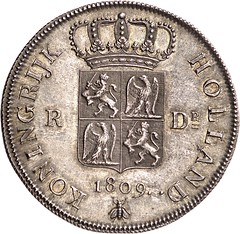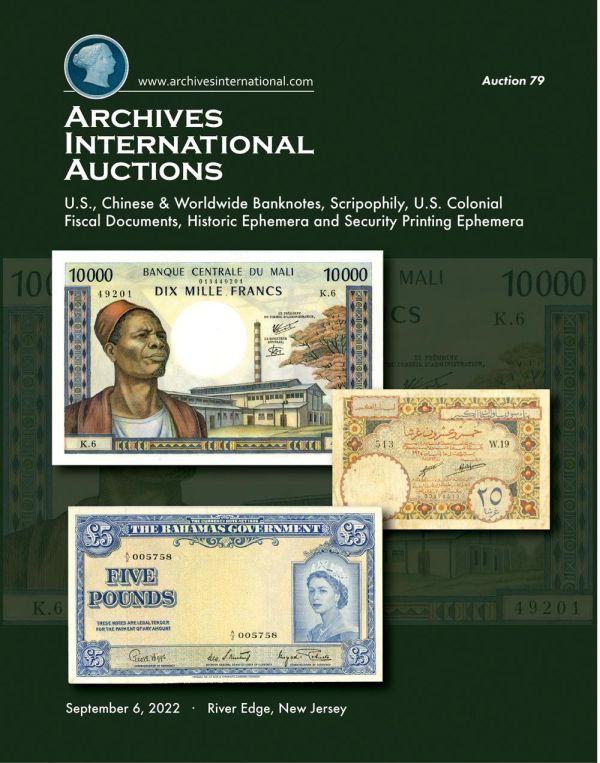
This article from Künker discusses coin of the Kingdom of Holland relating to the family of Napoleon Bonaparte.
-Editor
On 27 September 2022, Künker will auction off the collection of the Verschoor brothers. It contains what's probably one of the most important collections of coins from the Kingdom of Holland. Read about the fate of the short-lived kingdom and the numerous problems King Lodewijk had to deal with when introducing his new coins.
 Napoleon's second-youngest brother bore several names throughout his life. He was baptized with the name Ludovicus. In Corsica, the little boy was called Luigi. In France, where his older brother Napoleon provided him with a military education, we was called Louis. And when his brother made him king of the new Kingdom of Holland in 1806, Louis became Lodewijk. Unlike many other relatives and generals of Napoleon who sat on the thrones of Europe, Lodewijk actually managed to endear himself to his subjects.
Napoleon's second-youngest brother bore several names throughout his life. He was baptized with the name Ludovicus. In Corsica, the little boy was called Luigi. In France, where his older brother Napoleon provided him with a military education, we was called Louis. And when his brother made him king of the new Kingdom of Holland in 1806, Louis became Lodewijk. Unlike many other relatives and generals of Napoleon who sat on the thrones of Europe, Lodewijk actually managed to endear himself to his subjects.
A new kingdom needs new coins. If you are interested in the issues of the short-lived Kingdom of Holland – which must not be confused with the Kingdom of the Netherlands – you should take a close look at Künker's Fall Auction Sales. One of the most important collections on this subject will be on sale. It was built up by experts: the Verschoor twins, the owners of a well-known Dutch coin shop. They specialized in the patterns and coins of Lodewijk Napoleon. Dim Verschoor even published an important paper on the subject. Let's have a look at what their collection tells us about the coinage of the Kingdom of Holland.
A King for the Netherlands
In June 1806, the then 28-year-old Lodewijk moved to his new realm. One of his plans was to change the country's coinage system. For the time being, he still used the old denominations of the United Provinces and continued to mint popular trading coins such as ducats. However, he wished to centralize the production of coins in a royal mint in Amsterdam. Since he lacked the funds for this undertaking, the then best-equipped mint of his kingdom in Utrecht fulfilled this task. It was to continue to mint the Dutch coins until the 21st century.
The probably most important change that Lodewijk had in mind for the coins of the former Republic was to put his portrait on the now royal coins. If you take a look at the Verschoor Collection in the Künker catalog, you will particularly be impressed by the variety of different patterns, which testify that the introduction of these new issues went anything but smoothly.
Head and Legend
The first obstacle was the portrait. Dutch mint masters had little experience in depicting crowned heads. They were given a medal of the French artist Jean-Louis-Marie George as a model for their designs and a competition was held. Six months after the original deadline had passed, the engraver Joan George Holtzhey from Amsterdam, who was well-known throughout Europe but rather advanced in years, was commissioned with the coin design. Another six months later, in May 1807, Holtzhey submitted his patterns. The king did not like them. When he learned about this, the over eighty-year-old petitioned to be allowed to withdraw from the task.
So the court turned to a French engraver, namely to Jean-Louis-Marie George, who had created the medal that had been used as a model. He accepted and indeed quickly submitted patterns for a 50-stuiver coin with a successful portrait that satisfied the competent authorities.
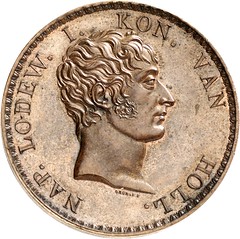
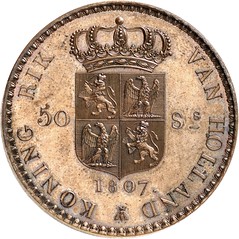
Lodewijk Napoleon: 50 stuiver 1807, bronze pattern. About FDC. Estimate: 10,000 euros. From Künker auction 373 (26/27 September 2022), No. 1088.
However, now the language barrier turned out to be a problem. A pattern from the Verschoor Collection perfectly illustrates this: It is an off-metal strike in copper from the dies of a planned new 50-stuiver silver coin, which had been created by George in Paris and was then sent to the Netherlands. On the reverse, the word kingdom was misspelled – KONING RIK instead of KONINGRIJK – and a VAN was mistakenly placed before HOLLAND. Both mistakes were criticized and then changed. Nevertheless, even some later patterns for other coins still displayed the wrong spelling. In defense of the engraver it should be said that George was only trying to follow contradictory and partially incorrect instructions from the Netherlands.
Lodewijk Napoleon: Rijksdaalder, 1809, Utrecht. Extremely rare. FDC. Estimate: 15,000 euros. From Künker auction 373 (26/27 September 2022), No. 1085.
And then there was the question of the royal title. Originally, Lodewijk had announced that he wanted to be referred to in the legend as LODEWIJK DE EERSTE, KONING VAN HOLLAND. With the new commission for George, a small but meaningful NAP. for Napoleon was added. Therefore, the already shown pattern of the 50-stuiver coin reads NAP. LODEW. I. KON. VAN HOLLAND. When the production finally was about to start, His Majesty changed his mind and demanded NAP. to be placed after, not before the LODEW. Requests like this one naturally resulted in further delays as completely new dies had to be created. Regarding one of the top pieces of the collection, the 1809 reichstaler, the mistakes of the pattern were corrected and it shows the title in the correct order, as we find it on most coins from the Kingdom of Holland.
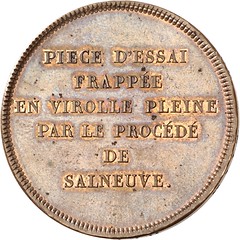
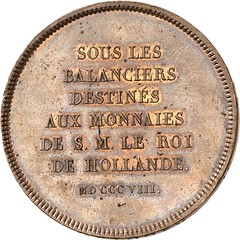
Lodewijk Napoleon: Copper pattern in the size of a reichstaler, 1808. Minted with the minting presses that were produced in Paris for the Utrecht mint. Ex. Coll. Virgil M Brand 6 (Sotheby's, Amsterdam 1984, No. 41) and Jacques Schulman, Amsterdam, purchased in 1924. FDC. Estimate: 300 euros. From Künker auction 373 (26/27 September 2022), No. 1077.
Technical Difficulties
Moreover, there were technical issues. Lodewijk wanted to modernize. He wanted to purchases the most advanced minting machines of the time, namely those that were used in Paris. These machines had among other things a collar that could be used to create edge inscriptions. After some toing and froing, several of the expensive presses were ordered from François Salneuve in Paris. However, here too, not everything went smoothly. For one, it took more time to complete the machines as expected because Salneuve lost a finger during the work. And a fiasco occurred when the machines were to be demonstrated to the responsible minister in Utrecht: Coins got stuck in the collar, got wedged in the complicated mechanisms of the machines and damaged them. Stamps hit each other without a blank between them and broke. The edge inscription had been illegible anyway. It took months to repair and overhaul the machines to the point where a new demonstration could be scheduled. Finally, the brand-new minting presses were ready for use – even if their productivity fell short of expectations. The Verschoor Collection contains some fascinating test issues that were produced with the new machines.
The King Abdicates
The presses had been operational since January 1809, but there were still more problems and hiccups to be solved before they supplied coins. Just a few months later, they stopped again. For Lodewijk had to abdicate as early as on 1 July 1810. History books report that Napoleon had had enough of his hesitant brother, who seemed to have forgotten to whom he owed his crown. Indeed, he was quite reluctant to carry out the emperor's orders out of concern for his subjects. This was especially true regarding Napoleon's Continental Blockade, which was intended to force Great Britain's economy to its knees but was highly damaging to the Netherlands at the same time.
So Napoleon decided to take the Kingdom of Holland and turned it into a province of France. Lodewijk – who was now Louis again – went into exile in Austria. The Dutch kept fond memories of him. After Napoleon's fall, it was even considered to reinstate him as king, but they then decided to go with someone from the House of Orange who did not bear the loaded name of Bonaparte .
Louis' life ended in Italy. One might wonder whether his friends there called him Luigi again.
The vagaries of history later led to his son becoming Emperor of France as Napoleon III.
Top image: Charles Howard Hodges: Portrait of Lodewijk Napoleon, King of Holland, 1809.
Literature:
George Sanders: De Parijse graveur Jean-Louis-Marie George (1755/6-1814), in: De Beldenaar 46, 2022, No. 3., pp. 134-155.)
To read the complete article, see:
A Bonaparte on Holland's Coins
(https://www.kuenker.de/de/information/presseinformationen/aktuelle-mitteilungen/444)
Wayne Homren, Editor
The Numismatic Bibliomania Society is a non-profit organization
promoting numismatic literature. See our web site at coinbooks.org.
To submit items for publication in The E-Sylum, write to the Editor
at this address: whomren@gmail.com
To subscribe go to: https://my.binhost.com/lists/listinfo/esylum
Copyright © 1998 - 2024 The Numismatic Bibliomania Society (NBS)
All Rights Reserved.
NBS Home Page
Contact the NBS webmaster
|






